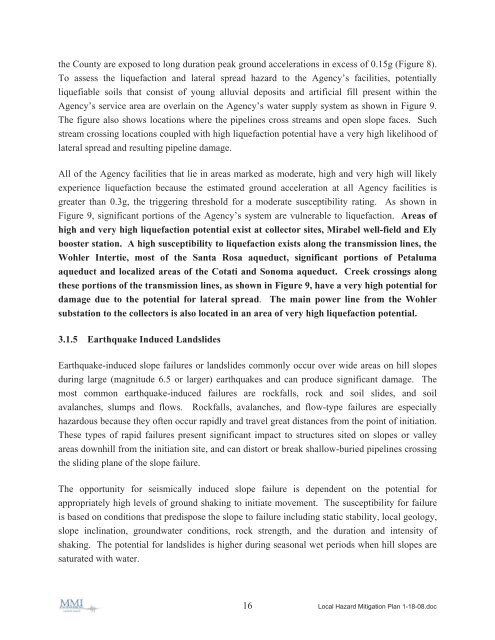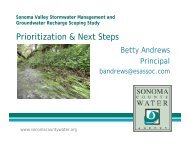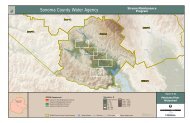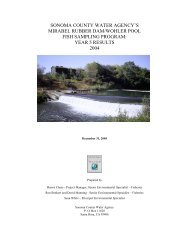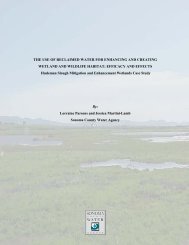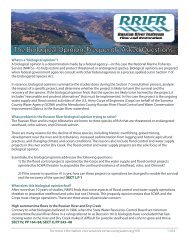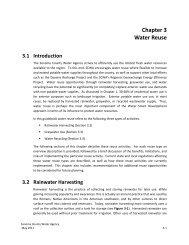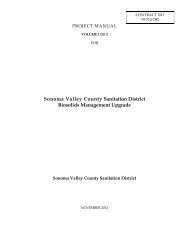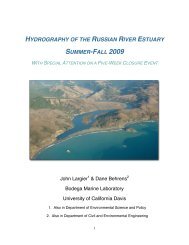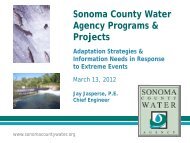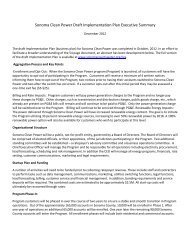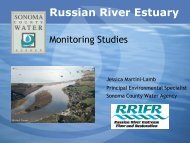Local Hazard Mitigation Plan.pdf - Sonoma County Water Agency ...
Local Hazard Mitigation Plan.pdf - Sonoma County Water Agency ...
Local Hazard Mitigation Plan.pdf - Sonoma County Water Agency ...
You also want an ePaper? Increase the reach of your titles
YUMPU automatically turns print PDFs into web optimized ePapers that Google loves.
the <strong>County</strong> are exposed to long duration peak ground accelerations in excess of 0.15g (Figure 8).<br />
To assess the liquefaction and lateral spread hazard to the <strong>Agency</strong>’s facilities, potentially<br />
liquefiable soils that consist of young alluvial deposits and artificial fill present within the<br />
<strong>Agency</strong>’s service area are overlain on the <strong>Agency</strong>’s water supply system as shown in Figure 9.<br />
The figure also shows locations where the pipelines cross streams and open slope faces. Such<br />
stream crossing locations coupled with high liquefaction potential have a very high likelihood of<br />
lateral spread and resulting pipeline damage.<br />
All of the <strong>Agency</strong> facilities that lie in areas marked as moderate, high and very high will likely<br />
experience liquefaction because the estimated ground acceleration at all <strong>Agency</strong> facilities is<br />
greater than 0.3g, the triggering threshold for a moderate susceptibility rating. As shown in<br />
Figure 9, significant portions of the <strong>Agency</strong>’s system are vulnerable to liquefaction. Areas of<br />
high and very high liquefaction potential exist at collector sites, Mirabel well-field and Ely<br />
booster station. A high susceptibility to liquefaction exists along the transmission lines, the<br />
Wohler Intertie, most of the Santa Rosa aqueduct, significant portions of Petaluma<br />
aqueduct and localized areas of the Cotati and <strong>Sonoma</strong> aqueduct. Creek crossings along<br />
these portions of the transmission lines, as shown in Figure 9, have a very high potential for<br />
damage due to the potential for lateral spread. The main power line from the Wohler<br />
substation to the collectors is also located in an area of very high liquefaction potential.<br />
3.1.5 Earthquake Induced Landslides<br />
Earthquake-induced slope failures or landslides commonly occur over wide areas on hill slopes<br />
during large (magnitude 6.5 or larger) earthquakes and can produce significant damage. The<br />
most common earthquake-induced failures are rockfalls, rock and soil slides, and soil<br />
avalanches, slumps and flows. Rockfalls, avalanches, and flow-type failures are especially<br />
hazardous because they often occur rapidly and travel great distances from the point of initiation.<br />
These types of rapid failures present significant impact to structures sited on slopes or valley<br />
areas downhill from the initiation site, and can distort or break shallow-buried pipelines crossing<br />
the sliding plane of the slope failure.<br />
The opportunity for seismically induced slope failure is dependent on the potential for<br />
appropriately high levels of ground shaking to initiate movement. The susceptibility for failure<br />
is based on conditions that predispose the slope to failure including static stability, local geology,<br />
slope inclination, groundwater conditions, rock strength, and the duration and intensity of<br />
shaking. The potential for landslides is higher during seasonal wet periods when hill slopes are<br />
saturated with water.<br />
16 <strong>Local</strong> <strong>Hazard</strong> <strong>Mitigation</strong> <strong>Plan</strong> 1-18-08.doc


